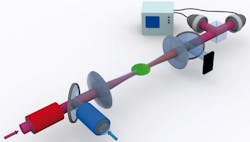Max Planck's single-photon switch brings quantum information processing closer
Garching, Germany--Researchers at the Max-Planck-Institute of Quantum Optics (MPQ) have developed a single-photon switch that could be used to develop a quantum logic gate necessary for quantum information processing: using light to process data.
The idea to perform data processing with light, without relying on any electronic components, has been around for quite some time. In fact, necessary components such as optical transistors are available. However, up to now they have not gained a lot of attention from computer companies. This could change in the near future as packing densities of electronic devices as well as clock frequencies of electronic computers are about to reach their limits.
Optical quantum computing techniques promise a high bandwidth and low dissipation power, in particular, if only faint light pulses are needed to achieve the effect of switching. The ultimate limit is a gate-pulse that contains one photon only. A team of scientists around Professor Gerhard Rempe, director of the Quantum Dynamics Division at MPQ the Max-Planck-Institute of Quantum Optics, has now managed to bring this almost utopian task into reality. The scientists succeeded in switching a medium—a cloud of about 200,000 ultracold atoms—from being transparent to being opaque for light pulses. This single-photon switch could be the first step in the development of a quantum logic gate, an essential component in the field of quantum information processing.
The experiment starts with cooling a cloud of about 200 000 rubidium atoms down to a temperature of 0.43 micro-Kelvin (this is just above absolute zero, which corresponds to minus 273 degree Celsius). The atoms are held in an optical dipole trap created by the crosswise superposition of two laser beams. The cloud is irradiated by two light pulses separated by 0.15 micro-seconds. The pulses are extremely weak, they contain on average one or even less photons. The first pulse—the so-called gate-pulse—gets absorbed inside the cloud. To be precise, it is stored as an atomic excitation, as it brings one of the atoms into a highly excited Rydberg state. The mere presence of the Rydberg atom leads to a shift of the corresponding energy levels of the other atoms in the cloud. Hence, the wavelength of the second pulse--the target pulse--no longer meets the requirements for excitation and gets blocked. In other words, the cloud of atoms acts as a medium that, on capturing one single photon, switches from being transparent to opaque. The storage of the photon can be maintained as long as the Rydberg state survives; that is, for about 60 micro-seconds.
The whole procedure is based on a sophisticated combination of a number of experimental measures. For example, the transparency of the cloud is achieved by the application of a control laser. "In order to trap the gate-photon we use the so-called slow-light technique," Stephan Dürr, leader of the experiment, explains. "When the photon is traversing the cloud it polarizes the surrounding medium and is slowed down to a velocity of 1000 km/h. As a consequence, the pulse length shrinks to a couple of tens of micrometers such that it is completely contained inside the cloud during a certain time window. If the control laser is switched off exactly in this time period, the pulse comes to a halt and is completely converted into an atomic excitation."
The second pulse is prepared with a polarization that cannot couple to the atomic excitation that has been stored before. This prevents the target pulse from reading out the stored photon. "Subsequently, we switch the control laser back on. A photon with the right polarization can retrieve the gate-photon from the cloud. We repeat this cycle every 100 micro-seconds," says Simon Baur, who works at the experiment as a doctoral candidate.
In a series of measurements the scientists were able to prove that the number of transmitted target photons was reduced by a factor of 20 if a gate-photon had been stored in the cloud before. "Our experiment opens new perspectives in the field of quantum information," Rempe resumes. "A single-photon switch could herald the successful storage of quantum information. That way, storage times could be improved. Last but not least, the new device could be the first step in the development of a quantum logic gate, a key element in quantum information processing."
The paper,"Single-Photon Switch Based on Rydberg Blockade" appears in Physical Review Letters.
SOURCE: Max-Planck-Institute of Quantum Optics (MPQ); http://www.mpq.mpg.de/cms/mpq/en/news/press/14_02_19.html

Gail Overton | Senior Editor (2004-2020)
Gail has more than 30 years of engineering, marketing, product management, and editorial experience in the photonics and optical communications industry. Before joining the staff at Laser Focus World in 2004, she held many product management and product marketing roles in the fiber-optics industry, most notably at Hughes (El Segundo, CA), GTE Labs (Waltham, MA), Corning (Corning, NY), Photon Kinetics (Beaverton, OR), and Newport Corporation (Irvine, CA). During her marketing career, Gail published articles in WDM Solutions and Sensors magazine and traveled internationally to conduct product and sales training. Gail received her BS degree in physics, with an emphasis in optics, from San Diego State University in San Diego, CA in May 1986.
